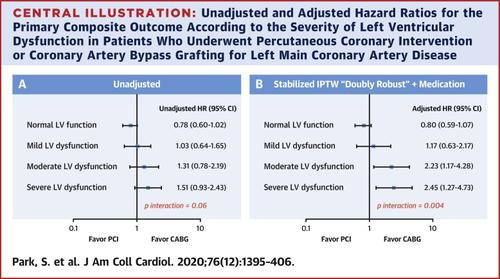当前位置:
X-MOL 学术
›
J. Am. Coll. Cardiol.
›
论文详情
Our official English website, www.x-mol.net, welcomes your
feedback! (Note: you will need to create a separate account there.)
Revascularization in Patients With Left Main Coronary Artery Disease and Left Ventricular Dysfunction
Journal of the American College of Cardiology ( IF 21.7 ) Pub Date : 2020-09-01 , DOI: 10.1016/j.jacc.2020.07.047 Sangwoo Park 1 , Jung-Min Ahn 2 , Tae Oh Kim 2 , Hanbit Park 2 , Do-Yoon Kang 2 , Pil Hyung Lee 2 , Yeong Jin Jeong 2 , Junho Hyun 2 , Junghoon Lee 2 , Ju Hyeon Kim 2 , Yujin Yang 2 , Kyungjin Choe 2 , Seung-Jung Park 2 , Duk-Woo Park 2 ,
Journal of the American College of Cardiology ( IF 21.7 ) Pub Date : 2020-09-01 , DOI: 10.1016/j.jacc.2020.07.047 Sangwoo Park 1 , Jung-Min Ahn 2 , Tae Oh Kim 2 , Hanbit Park 2 , Do-Yoon Kang 2 , Pil Hyung Lee 2 , Yeong Jin Jeong 2 , Junho Hyun 2 , Junghoon Lee 2 , Ju Hyeon Kim 2 , Yujin Yang 2 , Kyungjin Choe 2 , Seung-Jung Park 2 , Duk-Woo Park 2 ,
Affiliation

|
BACKGROUND
Left main coronary artery (LMCA) disease is associated with high mortality and morbidity due to a large area of jeopardized myocardium. However, the optimal revascularization strategy for patients with LMCA disease and left ventricular dysfunction is still unclear. OBJECTIVES
This study sought to examine long-term comparative outcomes after percutaneous coronary intervention (PCI) or a coronary artery bypass grafting (CABG) according to the severity of left ventricular dysfunction. METHODS
The authors evaluated a total of 3,488 patients with LMCA disease who underwent CABG (n = 1,355) or PCI (n = 2,133) from the IRIS-MAIN (Interventional Research Incorporation Society-Left MAIN Revascularization) registry. Left ventricular function was categorized according to left ventricular ejection fraction (LVEF) as normal function (LVEF ≥55%), mild dysfunction (LVEF ≥45% to <55%), moderate dysfunction (LVEF ≥35% to <45%), or severe dysfunction (LVEF <35%). The primary outcome was a composite of death, myocardial infarction, or stroke. RESULTS
Among the overall patient population, 2,641 (75.7%) patients had normal LVEF and 403 (11.6%), 260 (7.5%), and 184 (5.3%) had mild, moderate, and severe left ventricular dysfunction at baseline, respectively. Compared with CABG, PCI was associated with a higher adjusted risk of primary outcomes in patients with moderate (hazard ratio [HR]: 2.23; 95% confidence interval [CI]: 1.17 to 4.28) or severe (HR: 2.45; 95% CI: 1.27 to 4.73) dysfunction. In contrast, PCI and CABG had similar risks of the primary outcomes in patients with normal (HR: 0.80; 95% CI: 0.59 to 1.07) or mild (HR: 1.17; 95% CI: 0.63 to 2.17) dysfunction (p for interaction = 0.004). CONCLUSIONS
In the revascularization of LMCA disease, PCI was associated with an inferior primary composite outcome of death, MI, or stroke compared with CABG in patients with moderate or severe left ventricular dysfunction. However, the risk for the primary outcome was comparable between PCI and CABG in those with normal or mild left ventricular dysfunction. (Observational Study for Left Main Disease Treatment; NCT01341327).
中文翻译:

左主干冠状动脉疾病和左心室功能障碍患者的血运重建
背景 由于大面积受损心肌,左主干冠状动脉 (LMCA) 疾病与高死亡率和发病率相关。然而,LMCA 疾病和左心室功能不全患者的最佳血运重建策略仍不清楚。目的 本研究旨在根据左心室功能障碍的严重程度检查经皮冠状动脉介入治疗 (PCI) 或冠状动脉旁路移植术 (CABG) 后的长期比较结果。方法 作者评估了来自 IRIS-MAIN(介入研究协会-左主干血运重建)注册中心的 3,488 名接受 CABG(n = 1,355)或 PCI(n = 2,133)的 LMCA 疾病患者。左心室功能根据左心室射血分数(LVEF)分类为正常功能(LVEF≥55%),轻度功能障碍(LVEF ≥45% 至 <55%)、中度功能障碍(LVEF ≥35% 至 <45%)或严重功能障碍(LVEF <35%)。主要结局是死亡、心肌梗塞或中风的复合结局。结果 在总患者群体中,基线时 2,641 (75.7%) 名患者的 LVEF 正常,分别有 403 (11.6%)、260 (7.5%) 和 184 (5.3%) 名患者出现轻度、中度和重度左心室功能障碍。与 CABG 相比,PCI 与中度(风险比 [HR]:2.23;95% 置信区间 [CI]:1.17 至 4.28)或重度(HR:2.45;95% CI : 1.27 到 4.73) 功能障碍。相比之下,对于正常(HR:0.80;95% CI:0.59 至 1.07)或轻度(HR:1.17;95% CI:0.63 至 2)患者,PCI 和 CABG 的主要结局风险相似。17) 功能障碍(交互的 p = 0.004)。结论 在 LMCA 疾病的血运重建中,与中度或重度左心室功能不全患者的 CABG 相比,PCI 与死亡、MI 或卒中的主要复合结局较差相关。然而,在正常或轻度左心室功能不全的患者中,PCI 和 CABG 的主要结局风险相当。(左主干疾病治疗的观察性研究;NCT01341327)。
更新日期:2020-09-01
中文翻译:

左主干冠状动脉疾病和左心室功能障碍患者的血运重建
背景 由于大面积受损心肌,左主干冠状动脉 (LMCA) 疾病与高死亡率和发病率相关。然而,LMCA 疾病和左心室功能不全患者的最佳血运重建策略仍不清楚。目的 本研究旨在根据左心室功能障碍的严重程度检查经皮冠状动脉介入治疗 (PCI) 或冠状动脉旁路移植术 (CABG) 后的长期比较结果。方法 作者评估了来自 IRIS-MAIN(介入研究协会-左主干血运重建)注册中心的 3,488 名接受 CABG(n = 1,355)或 PCI(n = 2,133)的 LMCA 疾病患者。左心室功能根据左心室射血分数(LVEF)分类为正常功能(LVEF≥55%),轻度功能障碍(LVEF ≥45% 至 <55%)、中度功能障碍(LVEF ≥35% 至 <45%)或严重功能障碍(LVEF <35%)。主要结局是死亡、心肌梗塞或中风的复合结局。结果 在总患者群体中,基线时 2,641 (75.7%) 名患者的 LVEF 正常,分别有 403 (11.6%)、260 (7.5%) 和 184 (5.3%) 名患者出现轻度、中度和重度左心室功能障碍。与 CABG 相比,PCI 与中度(风险比 [HR]:2.23;95% 置信区间 [CI]:1.17 至 4.28)或重度(HR:2.45;95% CI : 1.27 到 4.73) 功能障碍。相比之下,对于正常(HR:0.80;95% CI:0.59 至 1.07)或轻度(HR:1.17;95% CI:0.63 至 2)患者,PCI 和 CABG 的主要结局风险相似。17) 功能障碍(交互的 p = 0.004)。结论 在 LMCA 疾病的血运重建中,与中度或重度左心室功能不全患者的 CABG 相比,PCI 与死亡、MI 或卒中的主要复合结局较差相关。然而,在正常或轻度左心室功能不全的患者中,PCI 和 CABG 的主要结局风险相当。(左主干疾病治疗的观察性研究;NCT01341327)。









































 京公网安备 11010802027423号
京公网安备 11010802027423号